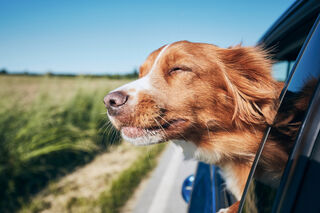Stress
Moving With Your Fur Family
How to keep your pet happy when moving.
Posted July 30, 2021 Reviewed by Tyler Woods
Key points
- Pets can get nauseous when flying by air or driving by car, make sure not to feed them 4-6 prior to travel.
- Give your pet a secure, comfortable room to themselves before introducing them to the rest of the house.
- Try to maintain your routines in your new home, including feeding and walking times.

Written by: Alison Gerken, DVM and Lisa Radosta, DVM, DACVB
This is Part Two of an article on decreasing your pet’s stress during the process of moving. Part One of this article discussed ways to prepare your pet for the move. Now you are ready to head to your new home!
The Move
Whether to drive or fly to your new destination can be a difficult decision. Regardless of your mode of transport, make sure that your pet is microchipped and up to date on vaccines.
Flying with your pet
Your pet may travel in most—but not all—commercial airlines in the cabin, as checked baggage, or in the cargo. This depends on the size of your pet, your destination, and the airline's requirements.
If your pet is traveling in cargo, then your pet will be checked in, transported to the aircraft, transferred between flights, and delivered at the destination by a handling crew. The cargo area of an aircraft can be stressful and pose safety risks to your pet.
Death and injury of pets during transit, while rare, have occurred. According to the Department of Transportation Air Travel Consumer Reports, there were 63 incidents with pets flying in cargo on major US airlines between 2015 and 2018. Pets may escape their crates, chew on their crates causing dental or oral injuries, scratch their crates causing broken nails or paw pad abrasions, and ingest pieces of their crates, which can cause significant gastrointestinal problems. Pets with heart disease or other medical conditions may be at higher risk when flying.
Whether your pet is housed in the cabin or in cargo, the plane’s acceleration, lift-off, pressure changes and sounds can cause significant stress.
Furthermore, flying with your pet may require documentation which can differ depending on the airline. This has led to some pet parents arriving for their flights only to learn that they do not have the correct paperwork and that the airline cannot transport their animal.
If you plan to fly, make sure you research all of your airline’s requirements for pet transport.
Driving with your pet
Driving with your pet will also require preparation. You will need to ensure all needed items, including the carrier or seatbelt harness, litterbox, water and food dishes, collars, leashes, bedding, toys and medications are readily accessible throughout the journey.
Maximize your pet’s safety by using a carrier or harness that has been dummy crash tested; you can find a list of products at The Center for Pet Safety.
If you are not using a product verified as safe by crash testing, placing your pet’s carrier on the floor of the vehicle behind the front passenger or driver seat is the safest way to secure your pet in the car.
Most importantly, never leave your pet alone in the car. Temperatures can rise to life-threatening levels in minutes even in 70-degree weather. Cracking windows does not reduce the risk of heat stress. Leaving your pet alone in the car for any amount of time is very dangerous. In fact, it is illegal in some states.
Many animals experience motion sickness during airplane or car travel. Do not feed your pet at least 4-6 hours prior to boarding your flight or getting into the car. If your pet has previously drooled or vomited on car or airplane rides, discuss using an anti-nausea medication for travel with your veterinarian.
Boarding
If your destination is nearby, consider boarding your pet at a friend’s house, boarding facility, or veterinary hospital to reduce your pet’s exposure to the commotion of moving and to minimize the risk of escape through an unmonitored door.
If your pet is more stressed when away from the family, then keep him in a quiet room with food, toys, and ambient sound while you move out.
Arrival in the New Home
Congratulations—you’ve made it!
When you arrive in your new home, before popping open the bubbly to celebrate your arrival, there are a few things to do to minimize your pet’s stress and keep your pet safe.
Pet-proof your home by hiding electrical cords, ensuring there are no sharp objects like nails, glass, or thumbtacks left behind if your home was newly constructed or renovated, and make sure that all windows and doors are secured.
Set up a secure, separate room for your pet while you move everything into the new home and where he can adjust before being gradually introduced to the rest of the home. Set up her bedding, and get out his favorite toys.
Set up your pet’s food and water station somewhere quiet, away from noisy appliances like the washing machine and air vents as well as away from foot traffic.
Keep and set out items familiar to your pet. Now is not the time to buy all new pet furniture along with your new furnishings.
Use dog or cat appeasing pheromones, like Adaptil® or Feliway®, diffusers that produce a natural calming effect on your pet. Each diffuser covers an area up to 750 square feet and lasts for about four weeks. If you are able to access your home before the move date, plug in the diffusers several days in advance of your arrival.
Try to keep your pet’s routine—mealtimes, outdoor excursions for elimination, or your familiar litter-scooping schedule—as well as your interactions as normal as possible for the first three months after your move.
With a little planning and preparation, your dream home can soon become your pet’s dream home too.




